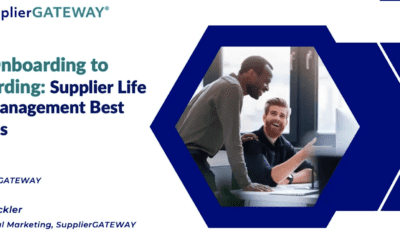Supplier Onboarding 101: A Beginner’s Guide
Your company has decided to implement a formal supplier onboarding program at your company. This decision is about to make your life as a procurement professional a whole lot easier, but it does come along with some setup. Onboarding your vendors and suppliers the right way is key to building successful, long-term relationships.
But where do you start?
Supplier onboarding can seem complicated, but it doesn’t have to be. This guide will walk you through the basics and help you get your program up and running quickly. We’ll cover goal-setting, creating a timeline, and common supplier onboarding roadblocks. With some guidance and practice, you’ll be onboarding suppliers like a pro and wondering why your company didn’t do this sooner. The benefits are huge and the effort is worth it.
Let’s get started!
What Is Supplier Onboarding?
To put it simply, supplier (or vendor) onboarding is the process of collecting necessary information from suppliers to set them up as approved entities to purchase from. Onboarding suppliers at the start of your relationship with them also helps your company build stronger relationships with your vendors right from the start.
What exactly does supplier onboarding involve? Essentially, it’s registering new suppliers into your procurement system and making sure they meet your company’s standards. You’ll collect information from potential suppliers like business licenses, insurance certificates, product details, and compliance documents. You’ll also evaluate things like their quality, delivery, and customer service to ensure they’re a good fit.
The benefits of solid supplier onboarding are huge. It helps you:
- Find the best vendors who share your values
- Gain visibility into who you’re buying from
- Reduce risk by verifying suppliers meet requirements
- Build partnerships with vendors who get your business needs
Onboarding new suppliers does take time and effort, but it’s worth it. Following a streamlined process will make things easier for both you and your new partners. Be open, honest, and willing to help vendors through the steps. Communicate with suppliers regularly throughout the process in case any issues come up.
With the right strategy and tools (cough SupplierGateway cough), you’ll be onboarding new suppliers quickly. Focus on creating a great experience for vendors, and you’ll build the foundation for long-lasting, mutually beneficial relationships. Onboarding is an investment that will pay off through better, more reliable suppliers and smoother purchasing.
Why Is Supplier Onboarding Important?
Supplier onboarding is crucial for any procurement team. Why is it so important? A few key reasons:
- It ensures compliance. Both internal policies and external regulations require proper vetting of suppliers. Onboarding helps you review suppliers against company standards, laws, and regulations.
- It reduces maverick spending. With a streamlined onboarding process, employees are more likely to choose approved suppliers that meet preferred qualifications. This avoids off-contract or non-compliant expenditures.
- It improves the supplier experience. A strategic onboarding program communicates your key expectations and makes the supplier relationship process smooth from the start. Suppliers feel valued and are better equipped to meet your needs.
- It drives cost savings. Approved suppliers that fully understand your requirements and standards often provide more competitive pricing and higher quality service. Onboarding also weeds out suppliers that can’t meet your criteria.
In summary, supplier onboarding should be a top priority for procurement pros. While it does require time and resources to implement, the benefits to your company’s bottom line, compliance, and supplier relationships make it well worth the effort. Onboarding suppliers correctly from the start creates a foundation for long-term success.
So take it step by step. Review your current processes, set clear goals, and choose an onboarding solution that fits your needs. Before you know it, you’ll have a program that transforms how you work with suppliers for the better. The results will speak for themselves!
Steps to Developing a Supplier Onboarding Program
Developing a solid supplier onboarding program takes time and effort, but the payoff—seamless integration of valued partners—is well worth it. Here are the basic steps to build your program:
Establish Clear Goals and Metrics
First, determine what you want to achieve with your onboarding program. Things like reducing risk, decreasing time to value, and improving supplier performance are common goals. Then establish key performance indicators (KPIs) to measure success, e.g. supplier compliance, cost savings, and quality metrics.
Design the Onboarding Process
Map out the end-to-end process for onboarding new suppliers, including:
- Supplier evaluation and selection: Develop standardized criteria to assess potential new suppliers.
- Supplier registration: Create an online portal where new suppliers can register their information. Collect essential details like contact info, capabilities, certifications, etc.
- Contracting: Establish templates for standard paperwork like NDAs, MSAs, and SOWs. Define an efficient workflow for legal review and approval.
- Supplier kickoff: Schedule an initial meeting to introduce the new supplier relationship, share key contacts and processes, align expectations, and address any questions.
- Performance monitoring: Regularly track supplier KPIs and compliance. Provide feedback and take corrective actions as needed.
- Continuous improvement: Solicit regular feedback from suppliers and internal stakeholders. Look for ways to optimize the onboarding program and strengthen supplier partnerships.
For a more in-depth article on the supplier onboarding process and best practices, see this article.
Deploy Supplier Onboarding Technology and Other Tools
The right technology can help streamline your onboarding efforts. A supplier portal, source-to-pay system, and contract lifecycle management platform are all helpful in managing various end-to-end processes.
Investing the time upfront to build a comprehensive supplier onboarding program will lead to higher-quality supplier relationships and better business outcomes. With the proper goals, metrics, processes, and tools in place, you’ll easily onboard new suppliers.
Tools and Resources to Streamline the Supplier Onboarding Process
Once you have defined your supplier onboarding program, you will need tools and resources to streamline the process. Using a central supplier portal and onboarding platform helps ensure consistency and provides an audit trail of all communication and documentation.
Supplier Onboarding Portal
A single online portal dedicated to supplier onboarding provides a flexible, automated solution that’s available on demand. Suppliers can log in to access and submit all necessary paperwork, certifications, and information in one place. For procurement teams, portals offer:
- A central communication hub to send messages, deadlines, and updates to suppliers
- Storage for all supplier documents, contracts, and compliance records
- Configurable, automated workflows to guide suppliers through your onboarding steps
- Reporting and analytics on supplier onboarding metrics and KPIs
Standardized Templates
Provide suppliers with standardized templates based on category type. Standard information like compliance questionnaires, product data sheets, or service agreements will differ depending on supplier type. Ensure you’re getting the correct information from the correct supplier. Segmenting in this way ensures you get the details you need in a consistent format while making the process faster and easier for suppliers to complete. You can then store finalized templates in your portal.
Collaboration Tools
Tools like shared drives, project management software, and video conferencing platforms facilitate collaboration during onboarding. Your supplier onboarding portal should allow for document sharing, but having another cloud-based file-sharing system to share draft documents, schedules, and other work-in-progress materials is helpful. Video calls are useful for remote suppliers or complex onboarding scenarios.
Learning Resources
Develop resources to educate suppliers on your organization’s processes, values, and best practices. These may include guidelines, video tutorials, checklists, or FAQ documents. Making this information easily available in your portal helps suppliers understand your requirements and what they need to do to get onboarded efficiently.
With the right tools and resources in place, you’ll find supplier onboarding becomes a streamlined, scalable process. Suppliers will have a positive experience from the start, and your team will gain significant time savings and improved oversight.
Common Challenges With Supplier Onboarding and How to Overcome Them
Supplier onboarding can be tedious and time-consuming if not approached strategically. Here are some of the most common challenges companies face when onboarding new suppliers and how to overcome them:
Speed
Onboarding suppliers manually is slow and inefficient. Develop guidelines and technical specs to speed up the process. Use supplier onboarding software like SupplierGateway’s Supplier Onboarding Platform to increase your onboarding speed.
Visibility
Without a standardized process, you lose visibility into where suppliers are in the onboarding journey. Create a checklist of required forms, approvals, and next steps to keep everything on track.
Compliance
Meeting regulatory and compliance standards is difficult without clearly documented processes. Define compliance requirements upfront and include review checkpoints to ensure all criteria are met before final approval.
Handoffs
Unnecessary handoffs between teams lead to stalled progress. Designate a primary contact for suppliers to prevent confusion and keep the lines of communication open.
Relationships
Building solid relationships with new suppliers takes time and effort. Schedule calls or in-person meetings to connect, address concerns, and convey your company’s values and priorities. Making a good first impression will set the foundation for a lasting partnership.
Onboarding suppliers may never be the most exciting task, but approaching it strategically with the right tools and processes can help you overcome common challenges. Focusing on speed, visibility, compliance, communication, and relationship-building will ensure a smooth transition so you can start reaping the benefits of your new supplier partnership.
Conclusion
You now have the basics to get started with your supplier onboarding program. By focusing on the fundamentals, setting clear goals, and choosing the right tools and technologies, you’ll collaborate with new suppliers in no time.
Remember, start small and build from there. Trying to onboard every supplier at once is overwhelming, so take your time to get the process right and make improvements. Supplier onboarding, like any new initiative, takes practice. Stay flexible, get feedback, and make changes as needed.
With the right mindset and approach, you’ll have a world-class program up and running before you know it. When you’re ready to take your supplier onboarding to the next level, schedule a demo and find out how SupplierGateway can help!











